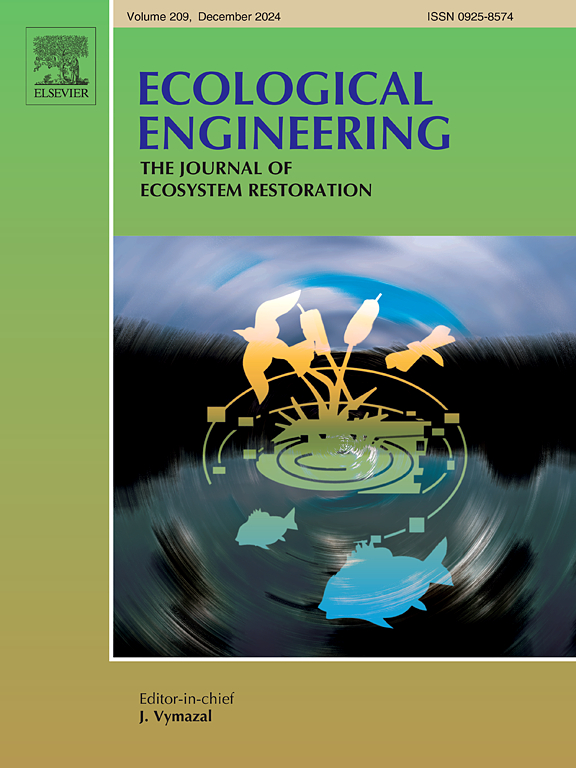青藏喜马拉雅山某高海拔水电站特有鱼类双入口鱼道最优流动条件的确定
IF 4.1
2区 环境科学与生态学
Q1 ECOLOGY
引用次数: 0
摘要
水电站的运行规律和水文条件会导致大坝下游水位的显著波动,影响鱼道入口的效率。设计一个有两个入口的鱼道,以适应下游水位的波动,可以帮助鱼类成功地向上游迁移。本研究的目的是考虑鱼的游动性能和鱼道入口水力学条件,确定双入口鱼道的运行模式和最优流动条件。为此,通过对XH河4种特有鱼种(裂腹鱼、华氏裂腹鱼、裂腹鱼和荣氏裂腹鱼)的鱼类游泳试验,在7种不同的大坝运行情景下,通过水动力条件的耦合,确定了鱼类的5个行为区(非变流区、诱导区、偏好区、爆发区和屏障区)。研究结果表明,本文提出了4种特有鱼类的诱导区(0.1 ~ 0.4 m/s)和偏好区(0.4 ~ 1.3 m/s),并提出了鱼类的潜在洄游路线和两个入口的潜在管理规则。结果表明,在A2情景下,鱼道1号入口可以运行,在A1和B2情景下,鱼道2号入口可以运行,而在B1、B3和c情景下,鱼道2个入口都需要运行。本研究突出了在西藏喜马拉雅调查案例研究中,双入口调节鱼道的重要性参考。并提出了其他高海拔水电站鱼道入口的设计方法,以提高鱼道效率。本文章由计算机程序翻译,如有差异,请以英文原文为准。
Identifying the optimal flow conditions of a fishway with two entrances for endemic fishes at a high-altitude hydropower station in the Tibetan Himalaya, China
Operational rules of the hydropower plant and hydrological conditions can lead to significant fluctuations of water levels downstream the dam and affect the efficiency of fishway entrance. Designing a fishway with two entrances to accommodate the fluctuations in downstream water levels can help fish successful upstream migration. This study aims at identifying the operating modes and optimal flow conditions of fishway with two entrances considering of fish swimming performance and hydraulics conditions at fishway entrances. Hence, fish swimming tests related to four endemic species including Schizothorax oconnori, Schizothorax waltoni, Ptychobarbus dipogon and Schizopygopsis younghusbandi in XH River to identify five behavioral zones (non-rheotactic, induction, preference, burst, and barrier zone) of fish by coupling of hydrodynamic conditions under seven different dam operational scenarios. It is found that the induction zone (0.1–0.4 m/s) and preference zone (0.4–1.3 m/s) for four endemic fish species, the potential migration routes of fish and potential management rules of two entrances have been proposed. The results suggested that #1 entrance of fishway can be operated in scenarios A2, and #2 entrance of fishway can be operated in scenarios A1 and B2, while both two entrances of the fishway needed to be operated in scenarios B1, B3 and C. This study highlights the importance reference for regulating fishway with two entrances at the investigated case study in the Tibetan Himalaya, and proposes a methodology of the fishway entrances for other high-altitude hydropower stations to improve fishway efficiency.
求助全文
通过发布文献求助,成功后即可免费获取论文全文。
去求助
来源期刊

Ecological Engineering
环境科学-工程:环境
CiteScore
8.00
自引率
5.30%
发文量
293
审稿时长
57 days
期刊介绍:
Ecological engineering has been defined as the design of ecosystems for the mutual benefit of humans and nature. The journal is meant for ecologists who, because of their research interests or occupation, are involved in designing, monitoring, or restoring ecosystems, and can serve as a bridge between ecologists and engineers.
Specific topics covered in the journal include: habitat reconstruction; ecotechnology; synthetic ecology; bioengineering; restoration ecology; ecology conservation; ecosystem rehabilitation; stream and river restoration; reclamation ecology; non-renewable resource conservation. Descriptions of specific applications of ecological engineering are acceptable only when situated within context of adding novelty to current research and emphasizing ecosystem restoration. We do not accept purely descriptive reports on ecosystem structures (such as vegetation surveys), purely physical assessment of materials that can be used for ecological restoration, small-model studies carried out in the laboratory or greenhouse with artificial (waste)water or crop studies, or case studies on conventional wastewater treatment and eutrophication that do not offer an ecosystem restoration approach within the paper.
 求助内容:
求助内容: 应助结果提醒方式:
应助结果提醒方式:


